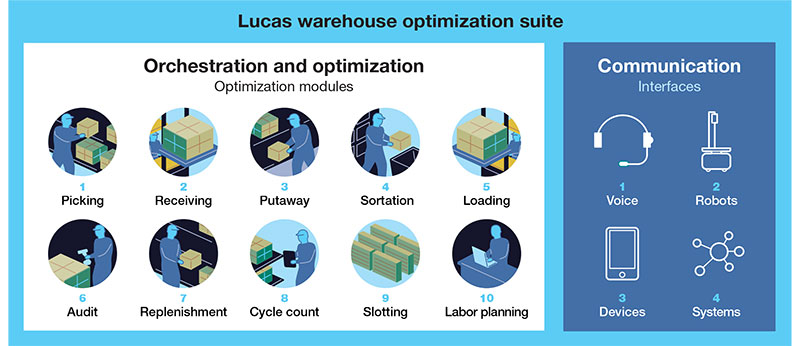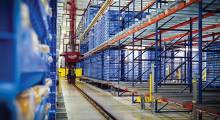Nearly everyone, it seems, wants to get better at warehouse execution. And with good reason. There’s more automation in DCs than there used to be.
Research firm Interact Analysis estimates that by 2027, more than a quarter of DCs (26%) will be automated, up from 18% at the close of 2021. This should drive interest in warehouse execution system (WES) software, since few operations have one tightly integrated, do-it-all system.
Many automated DCs rely on a mix of automated systems, from traditional fixed automation to newer solutions that leverage autonomous mobile robots (AMRs) to accelerate throughput. The need to synchronize this mix of assets with other resources drives interest in WES.
WES grew out of the need to do smart order release across various zones of automation to create a level flow of work across a DC in a way most warehouse control systems (WCS), or for that matter higher-level warehouse management systems (WMS), could not. WES sits in between these layers, at times overlapping, but mainly serving as way to orchestrate everything that needs to happen in the middle.
The WES space is populated by diverse vendors—WMS software providers like Manhattan Associates or Körber who’ve devised WES modules, systems integrators who’ve developed WES software, and some warehouse automation providers with software capabilities. The landscape can be looked at more broadly to include providers focused on work execution with mobile or wearable devices or AMR vendors who’ve added software beyond a narrow focus on fleet management.
All of this overlap can lead to confusion, but take a step back, say WES providers, and it comes down to how well a system can orchestrate a DC’s total mix of resources—automation systems, people and inventory—given the current pool of orders and service-level targets.
“Basically, WES is about dynamically directing and orchestrating people and automated equipment to get goods from point A to point B most efficiently to meet customer commitments,” says Ed Romaine, vice president of marketing and business development with New Dawn, which offers WES. “The WMS and WCS layers of software were never really intended for this orchestration role.”
While most companies deploying WES have some automation, vendors point out that WES benefits highly automated DCs, but it can also help more lightly automated ones. Others note that with automation like put walls or goods-to-person (GTP) systems, the solutions are inherently a blend of machine and labor resources and should be optimized with this in mind.

“Almost every facility has some non-automated or lightly automated processes, and they can benefit through WES capabilities both in terms of their own efficiency and as part of the overall flow of work and inventory,” says Dan Gilmore, CMO for Softeon, a supply chain execution software provider with a WES solution.
The labor equation
For example, says Gilmore, some operations aren’t heavily automated, but they have adopted automation like put walls or AMRs that need labor support. Additionally, he adds, most DCs have a mix of automated and manual zones they need to coordinate.
“We are also seeing a lot of interest in WES in DCs where there might be a number of processing areas, such as for example robotic automatic guided vehicles, automated layer picking, manual case picking with RF or voice, and more,” says Gilmore. “The scope of WES use cases continues to expand. It’s all about getting the right work to the right employees considering current and projected demand by process area.”
For Softeon’s WES, a dynamic rules engine supports orchestration timing. “The Softeon WES leverages a dynamic rules engine that knows how long the picking and packing process for each order will take and automatically releases orders to the floor such that all the orders for a given carrier make the cutoff times without the stress and modest chaos often seen in making this happen manually,” says Gilmore. “That can also include a resource allocation capability in the WES that looks ahead at the order pool and the cutoff times and assigns associates in picking, packing and replenishment activities so that sufficient labor is in place to make all the cutoff times, in balance with any automation, such as automated packing equipment.”
In general, says Romaine, WES solutions offer more opportunities for efficiencies for DCs with multiple zones of automation. Though as part of its load balancing functionality, WES can consider labor requirements, and managers can use dashboards to see where labor may need to shift. WES modularity also helps more lightly automated DCs deploy WES.
“True modularity allows an operation to deploy just the WES functionality it needs, which helps with acquisition cost, and also for future service and support reasons,” Romaine says.
WES and GTP
When it comes to GTP-type systems based on AMRs or automated storage and retrieval systems (AS/RS) or with picker workstations, WES software can take into account both labor and automation resources as part of upstream order release logic, says Jordan Mitchell, senior director of product management with FORTNA.
FORTNA’s WES does that today, Mitchell adds, especially with robotic AS/RS solutions that work on a pull principle based on how many pickers are logged on and completing order totes.
“If Joe, Bob or Suzie don’t show up for their shift, or one of them doesn’t come back from lunch break on time, the capacity for your system becomes limited, so the WES should be able recognize that and throttle the demand,” Mitchell says. “It can’t reduce that demand, because it’s already been dropped to the system, but with WES, you can throttle that demand to specific workflows, and we support that today for cube AS/RS and goods-to-person automation.”
When such GTP solutions are managed by a WES, Mitchell says, the solution can build in some small inventory buffers and then use a pull principle to throttle the pace of work being assigned to workstations based on the number of workers logged on and picking. As order totes get completed, the system pulls in more work, and it’s under this principle that a WES can detect a labor constraint and make adjustments.
Similarly, a WES can take into account the number of associates available to decant cases and replenish items into the bins of a cube AS/RS or other GTP solutions, Mitchell adds.
“When you get replenishment of inventory coming down a conveyance line to a cube AS/RS, [our WES] can route the goods to different decant stations depending on who’s available and which stations are open,” Mitchell says. “We are replenishing inventory into the system based on the capacity of the humans that are there to do that work.”
Work optimization
Warehouse improvement initiatives also bring into play solutions that focus on optimizing human-centered workflows and tie into WMS, but aren’t strictly a WES. For example, Lucas Systems provides its Warehouse Optimization Suite as an optimization layer between WMS and work activities on the floor. While some orchestration can be involved with mobile robots, the suite is aimed at accelerating human-centered process like picking or replenishment at the point of execution, says Ken Ramoutar, chief marketing officer for Lucas Systems.

“Our approach is to bring a new level of intelligence to the actual work processes and work execution inside of warehouses,” says Ramoutar. “Our Optimization Suite is bringing smarts—an optimization and orchestration layer—to processes that today are mostly carried out by associates.”
The suite’s functions include AI-based optimization for batching and prioritization of work to the floor, which optimizes pick paths for associates picking with voice wearables to cart, or doing other processes like audits, Ramoutar explains, to minimize travel.
That optimization is invisible to the workers, who interact with Lucas’s Jennifer voice system to guide their work hands-free. For the operation, it means improved throughput, and for the front-line worker, work optimization makes tasks easier and safer because they don’t have keep looking at an RF device screen, or at paper pick lists.
“A key goal with work optimization is to enable the workers to do their jobs in a less stressful, easier way, and as result of that, you get a lot more done, and workers don’t feel as stressed out at the end of the day,” Ramoutar says.
Operations that have deployed Lucas Systems’ work optimization and voice platform include Rotary Corp., a Glenville, Ga.-based supplier of outdoor power equipment parts, tools and accessories. The optimization and voice have helped Rotary keep up with its same-day shipping promise for orders received by mid-afternoon, in large part by increasing throughput by 40% since the system was deployed.
Ramoutar points out that while voice technology helps with accuracy and productivity, it’s the software logic for smart batching and travel path optimization driving productivity gains. “It’s really the optimization smarts behind the scenes that make it all happen,” he says. “That is the key to raising pick densities for the workers.”
Since the Lucas solution knows all the tasks and paths in an operation, it can be used to help trigger when mobile robots are needed for automated transport of completed order totes or larger items or cases. The system can communicate with AMR fleet software or automation systems using standard interfaces should a human-centered workflow need to hand off some goods, based on this knowledge of where workers are at in a process, Ramoutar explains.
New directions
Leading WES solutions have become highly productized applications built and deployed on a microservices architecture, and evolving to address new market niches, even if orchestrating resources and workflows remain WES’s core benefit, says Art Eldred, vice president and growth officer with VARGO, whose COFE WES solution has been used by companies including Gap Inc. to optimize order fulfillment by sequencing and synchronizing workflows to hit service levels.
While COFE, which stands for Continuous Order Fulfilment Engine, has been deployed at large-scale fulfillment centers, it’s not limited to big, highly automated DCs, says Eldred. Smaller, more lightly automated warehouses or even retail store back rooms can benefit from its core capabilities and a microservices architecture to enable easy deployment, he adds.
“WES can definitely serve many types of fulfillment operations,” says Eldred. “COFE today can be a good fit for the back room of a store, deployed in the cloud, using the same technology stack and application functionality that a 1-million-square-foot DC would use it for. We’re able to leverage some of those same algorithms and application services to optimize smaller-scale operations that need to optimize pick, pack and ship processes in a confined space with limited resources. The scale may be smaller, but you’re still trying to synchronize resources and maintain certain service levels.”
To be adaptable for smaller operations, a WES should be modular and use a microservices so just the functions needed can be applied, says Eldred.
“With our core fulfillment engine, a smaller operation or micro-fulfillment site can use light automation like RF devices and as that business grows and adds more automation like mobile robots, or an auto-bagging machine, we’ve already given them the foundational blocks, and it’s just adding on another module,” says Eldred. “It’s a very easy lift to expand WES to synchronize more automation at that point. The move to software containerization is critical in addressing that lower tier of the market.”
Eldred adds that COFE can sequence and synchronize the range resources found in a fulfillment operation: materials handling equipment, devices and employees, given the current pool of orders and available inventory. If one process starts to get bogged down, the WES can re-prioritize work to bring the flow back into balance, he explains.
That orchestration benefit, Eldred adds, is why WES suits even a micro-fulfillment site, as these operations also need to synchronize a blend of resources to meet customer expectations, and without a lot of space to do it in. “Technology like mobile robots is going to come into stores to enable efficient fulfillment, and to me, you can’t do that without some software fulfillment engine to manage the workflows and diverse resources around the needed service level.”
Article topics











